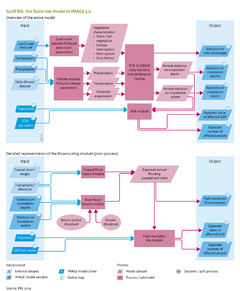Flood risks/Description
Parts of Flood risks/Description
| Component is implemented in: |
|
| Related IMAGE components |
| Models/Databases |
| Key publications |
| References |
Model description of Flood risks
Model core
GLOFRIS estimates the effect of land cover and climate change on global flood risks in river catchments and coastal areas (Winsemius et al., 2012; Ward et al., 2013). Global flood risks are expressed as the projected number of people affected annually and as GDP value. GLOFRIS uses land-cover input from IMAGE and climate time series, such as the IPCC GCM projections. These input data drive the global hydrological model, PCR-GLOBWB, the computational core of the module. PCR-GLOBWB calculates where and when flooding events may occur, and calculates the inundation extent and inundation depth needed to estimate flood risks. PCR-GLOBWB has features, namely daily time steps and proper accounting of the relationship between non-linear soil moisture and run-off, that make it appropriate for simulating flooding events. The spatial resolution currently used by the model is 0.5x0.5 degrees. The model steps of GLOFRIS are shown in the flowchart.
Land cover
Basis for the parameters in PCR-GLOBWB is the land-cover map Global Land Cover Characterization (GLCC), which express the hydrological characteristics of various land-cover types. IMAGE and PCR-GLOBWB are linked by lookup tables that translate the IMAGE land-cover classification into that of GLCC (Loveland et al., 2000).
PCR-GLOBWB requires data on daily precipitation, potential evaporation and temperature that are consistent with the IMAGE scenario (Van Beek et al., 2011; Wada et al., 2011). Daily data are required because these reflect inter-monthly and inter-annual climate variability and the effect on flood risk.
Flood hazard
PCR-GLOBWB includes a routing component on river flooding that estimates inundation proportions and average inundation depths on a time-step basis to estimate flood risk. GLOFRIS scenarios typically cover a 30-year or longer climatological model run. From this time series, annual extreme values of the inundated proportions and water depths are derived and summarised in an extreme value probability distribution. This probability distribution is subsequently used for annual projections on the damage of flood risk.
GLOFRIS estimates flood risk on two scales 0.5x0.5 degrees for global analyses, and 1x1 km2 for specific case studies. On a global scale, the extreme value probability distribution is directly combined with data on population and GDP, using a linear flood level–damage relationship. Thus for each year of simulation, the most extreme water level and inundated proportion from PCR-GLOBWB is used to calculate the maximum damage (in GDP or population) per grid cell.
An algorithm is implemented to scale down the 0.5x0.5 degrees maps of the extent and depth of annual maximum inundation to 1x1 km2, using a high-resolution digital elevation model. A scale down is needed because the spatial variability of flood hazards and flood exposure may be large and not well represented on the coarser scales in IMAGE and PCR-GLOBWB. A more accurate estimation of flood risk is obtained by converting the results to a higher resolution. The downscaling procedure may also include the risk of coastal flooding (see the flowchart, bottom).
Downscaling
For scaling down in river catchments, annual extreme values of inundation depths and proportions are transformed to bank-full volumes and excess volumes per 0.5 degree cell. The bank-full volume represents the volumetric capacity of a river channel in a grid cell and is estimated according to flood volume in a user-defined return period in which flood volumes do not exceed the bank-full volume (return period threshold in the flowchart, bottom) under current climate and land-cover conditions. The excess bank-full volume for each year is scaled down by estimating a water level from identified river pixels. This is determined by the user-defined stream threshold (see the flowchart, bottom) that generates a flood volume in the surrounding connected pixels, resulting in the same flood volume estimated from the 0.5x0.5 degree results. The method is mass conservative with respect to the PCR-GLOBWB results on 0.5x0.5 degree cells.
Coastal flood
Coastal flood hazard maps are established using the DIVA database. DIVA contains estimates on 1-, 10-, 100- and 1000-year water levels along a large number of coasts worldwide (Hinkel and Klein, 2009). These coastal flood probabilities are combined with those on river flooding by finding the upstream connected pixels on the high-resolution elevation map that are lower than the coastal water levels. It is assumed that the height of a wave reduces as it moves inland and that the water spreads over the surface, resulting in lower water levels inland than on the coast.
Flood risk
After the high-resolution flood hazard maps have been established, the annual extreme values can be combined to form average annual flood hazard maps and flood risk maps. At this scale, more local detail can be added about cropland locations, high-resolution maps on population and GDP and other exposure data of interest. The resulting flood hazard maps can be combined with these high-resolution maps and, if possible, in more localised damage models.
More information about GLOFRIS, its underlying models and methods, and the downscaling module is available in Winsemius et al., 2012 and Ward et al., 2013.
